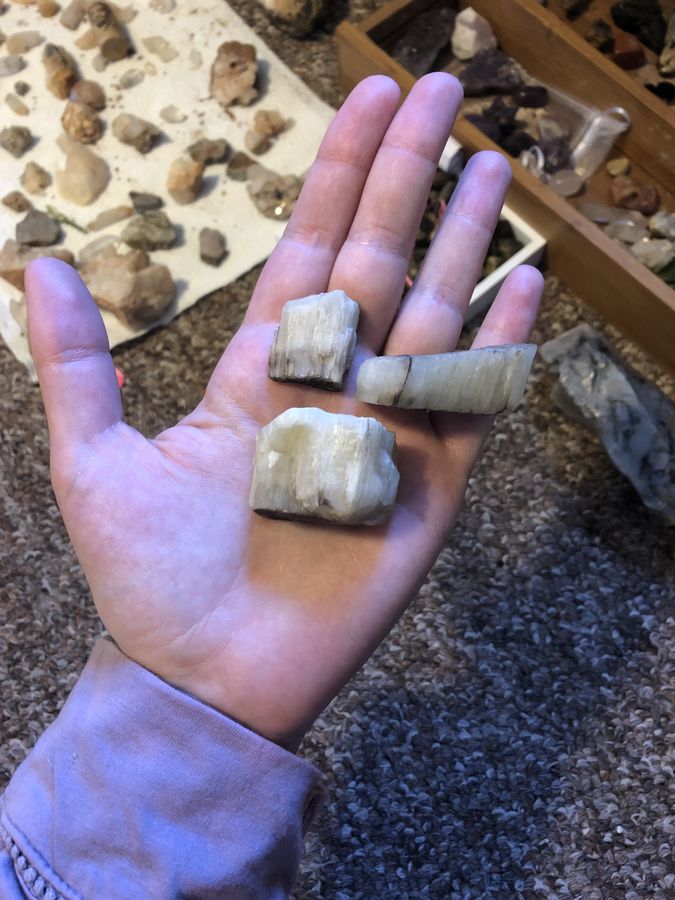| View previous topic :: View next topic |
| Author |
Message |
MadeeMac
Joined: 18 Apr 2021
Posts: 3
Location: Indiana


|
 Posted: Apr 19, 2021 07:21 Post subject: Opal soil finds Posted: Apr 19, 2021 07:21 Post subject: Opal soil finds |
|
|
Hey everyone! I found many of these prices while seiving gallons of opal soil from South Dakota in a research lab. exact locality unknown. They were covered in CaCO3 but I put them is acid and removed most of it. They do not scratch with a finger nail, or a regular nail. I took them to my teaching assistant in my physical geology class and he doesn’t know either! Any ideas? It’s not selenite. It is fibrous and a yellowish white color.
| Mineral: | Unknown |
| Dimensions: | 3cm |
| Description: |
|
| Viewed: |
4418 Time(s) |

|
|
|
| Back to top |
|
 |
Matt_Zukowski
Site Admin
Joined: 10 Apr 2009
Posts: 737
Location: Alaska



|
 Posted: Apr 19, 2021 08:45 Post subject: Re: Opal soil finds Posted: Apr 19, 2021 08:45 Post subject: Re: Opal soil finds |
|
|
Since you have access to a geology dept, you can do some good testing. I'd try to do better on the harness - does your dept have any hardness scribes? Also you can do a specific gravity test. You might also want to try to get better locality info - that can help constrain the possibilities quite a bit.
All this said, looks like qtz or maybe feldspar to me.
Good luck.
|
|
| Back to top |
|
 |
Peter Megaw
Site Admin

Joined: 13 Jan 2007
Posts: 973
Location: Tucson, Arizona



|
 Posted: Apr 19, 2021 09:43 Post subject: Re: Opal soil finds Posted: Apr 19, 2021 09:43 Post subject: Re: Opal soil finds |
|
|
Given that these are coming from an opal deposit , the hardness and KISS says something siliceous is a likely possibility. The fibrous texture looks like satin spar (gypsum) or certain pedogenic carbonate deposits...again KISS says these fit the environment. Before doing more physical testing as Matt suggests (highly desirable, but you've made a good start) try hitting it with a UV light to see if it fluoresces...much pedogenic opaline silica products pick up enough uranyl to fluoresce bright yellow-green, especially if the source of the free silica is devitrifying volcanic glass. A cheap "UV" laser pointer (405 nm) or "scorpion light" (365 nm) will suffice to get an initial result.
I think if you put the pieces together (fibrous mineral + free silica + pedogenic environment) you may be looking at silica replacement of a fibrous precursor. Instead of leaching off the calcite coating, can you cut or break one in half and see what the "contact" between the coating and the core looks like...you may find it is transitional suggesting the precursor was fibrous calcite, or sharp suggesting a coating of something fibrous previously silicified. In the latter case you will probably never know precisely what that precursor was. Given how much silica was floating around in that environment I would suspect you'll find other things that got silicified (roots, snail shells, worm burrows) or coated (pretty much anything).
A quartz crystal or broken chunk of quartzite will serve as a hardness tester, but watch out since the stuff may appear harder along the grain than across it. Remember, in this case, you may not actually be testing the hardness of the mineral, but rather that of the rock which is a different matter. If you want to test the specific gravity quickly and easily John Betts' talk from Saturday's virtual Rochester Symposium is a great and simple technique for testing specific gravity without really having to know what you're doing...although he explains in deep but straightforward detail what you are doing. It's worth a watch regardless. I believe it is on Youtube by now
_________________
Siempre Adelante! |
|
| Back to top |
|
 |
Pete Modreski
Site Admin

Joined: 30 Jul 2007
Posts: 710
Location: Denver, Colorado



|
 Posted: Apr 22, 2021 11:41 Post subject: Re: Opal soil finds Posted: Apr 22, 2021 11:41 Post subject: Re: Opal soil finds |
|
|
| Peter Megaw's comments should be very helpful to you, about it appearing to be some form of (something-replaced-by) silica, with a fibrous structure. It simply being petrified (silicified) wood is a likely possibility, too! Good luck doing some more tests and narrowing this down.
|
|
| Back to top |
|
 |
|





